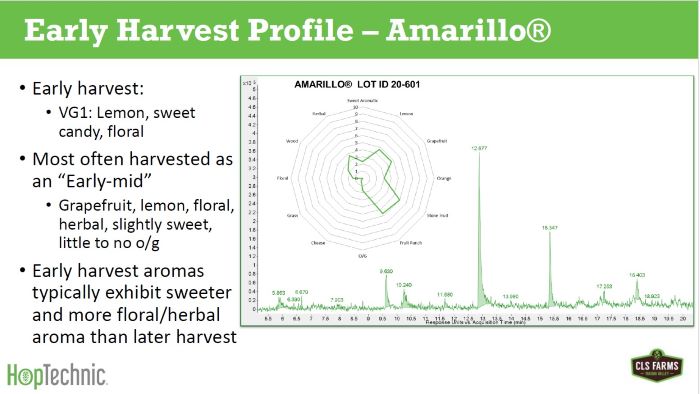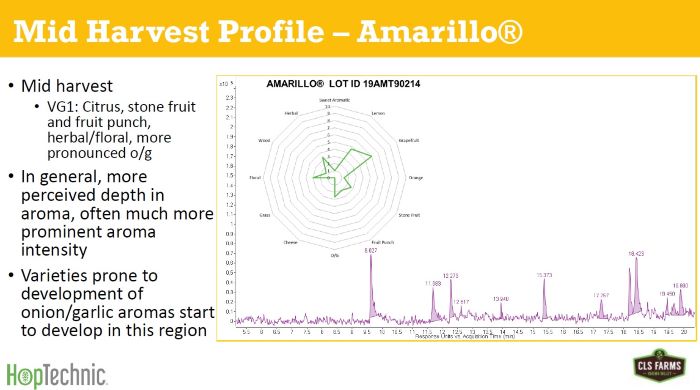From Vol. 7, No. 1, May 2023
HopTechnic is a subsidiary of Virgil Gamache Farms in the Yakima Valley; it grew out of a first lab in what was originally the kitchen on the family farm. A system lead chemist Stephanie Conn uses there—a gas-chromatography flame-ionization detector/sulfur chemiluminescence detector (GC-FID/SCD)—allows her an opportunity to examine hops in a way few others have.
The graphs she shared, along with more numbers from Tom Nielsen at Sierra Nevada Brewing, during a Craft Brewers Conference seminar sponsored by CLS farms may look intimidating at first, but the information is of value to both brewers and other hop growers (including home brewers and growers). I highly recommend looking at the presentation and the accompanying audio recording CLS has made available.
A few takeaways:
– The seminar was titled “Finding the Edges” because of the current interest in hops with intense aroma. That has meant pushing them as far as possible before the aroma becomes unpleasant (think onion and garlic).
– CLS co-owner Eric Desmarais talked about how his farm has moved from fixed “best” dates to more dynamic ones. Much of that has been by constantly visiting the fields and assessing the progress of each cultivar. Data from HopTechnic provides both direction and confirmation. But the feedback isn’t instant. It takes time to collect, and sometimes decisions must be made immediately.
– This sounds much like what Freestyle Hops in New Zealand is doing, again seeking to provide more of compounds brewers say they want. “We believe our lots have much higher concentrations of those compounds because of an array of process changes we’ve made over the last five years,” managing director David Dunbar explained via email. “Our internal data would suggest that while there isn’t any single key change, there are a few things that are more impactful than others. First, we’ve shifted to harvesting based on field sensory, rather than dry matter or alpha or conventional wisdom or forms of witchcraft or whatever.”
– Nielsen, raw materials manager at Sierra Nevada, said that it was almost 20 years ago that Darren Gamache, supervisor at Gamache Farms, told him that one out of four years “things happen and you just don’t know why.” In those weird years, said CLS advisor Alex Newell, “leaning on analytics can help us navigate.”
– Nielsen described picking hops too early—producing hops with grassy and muted aromas—as “heartbreaking.”
– Because of the interest in thiols, there’s new research going on to measure the impact of picking dates on their production. For instance, researchers measured higher levels of 3-mercapto-4-methylpentan-1-ol (3M4MP, which contributes to passion fruit, grapefruit, rhubarb and guava character) in Cascade hops that were picked later. Nielsen pointed out that the “geraniol piece” is not as well understood. That includes not just geraniol but also geranyl acetate, which may be converted into geraniol during fermentation.
Amarillo, Cascade, Comet and El Dorado are all rich in geranyl acetate. “There are five or six geraniol esters that are important and El Dorado is off the charts in them,” Nielsen said, emphasizing that the importance of the geraniol component, and the compounds that result from biotransformation, should not be overlooked when talking about modern IPAs.
– Slides 19 through 28 make it easy to visualize how odor compounds, and the resulting aromas, change as hops mature. Here are two of them.


– Maturity may refer not only to the current season. First year plants mature seven to 10 days later. “Age of the yard makes a big difference,” Desmarais said. Research by Suntory Beer in Japan focused on Saaz hops confirms that.
– Virus free fields—every farmer would like to say their yards are virus free, but they know better—may take longer to produce the compounds brewers want for IPAs. There’s more research to be done to explain why, which may intersect with research into the possible role stress could play in the production of thiols.
Additional reading. I’ve written a couple of related articles for Brewing Industry Guide, which you can find in print or archived here: “Hop maturity: The impact of when they pick” and “The evolving quest for more thiols.”